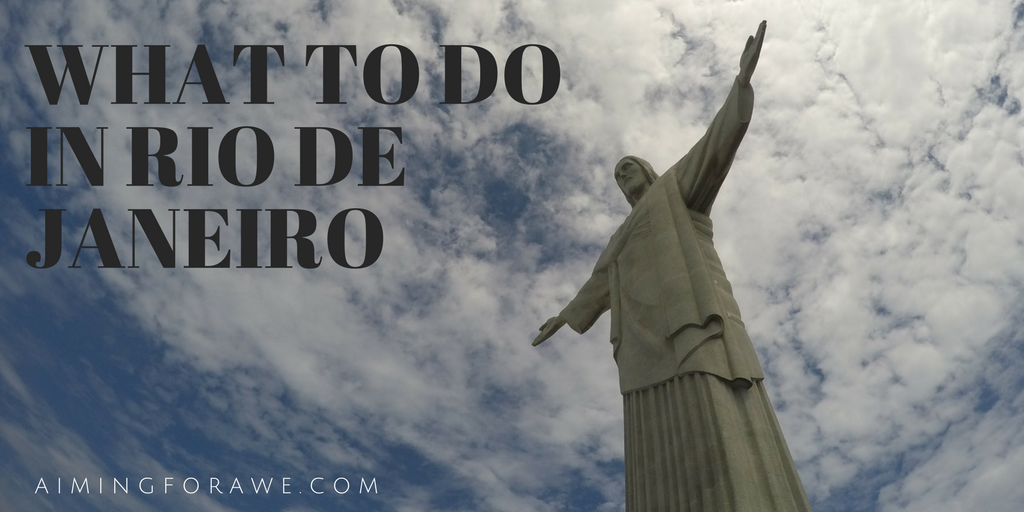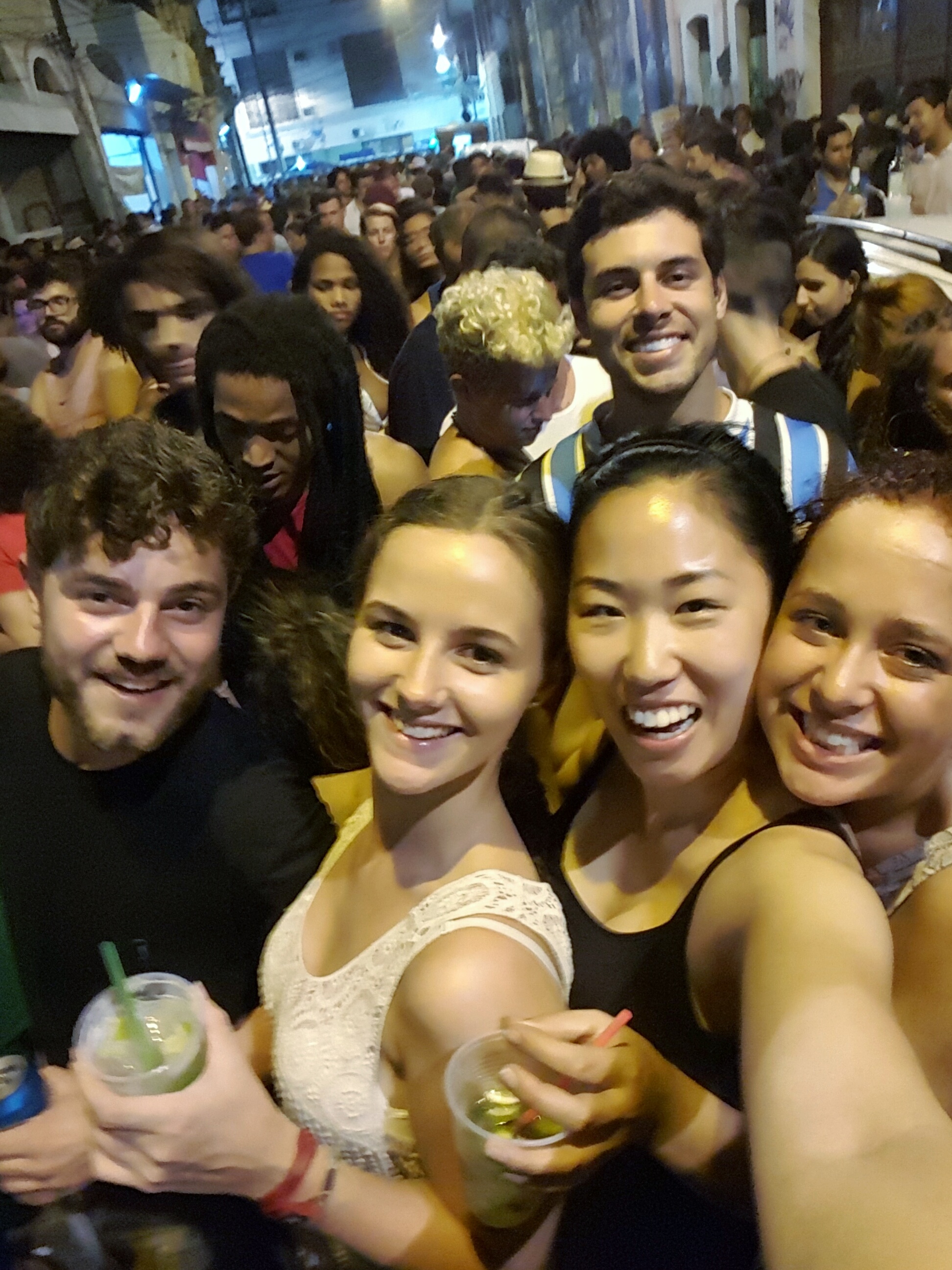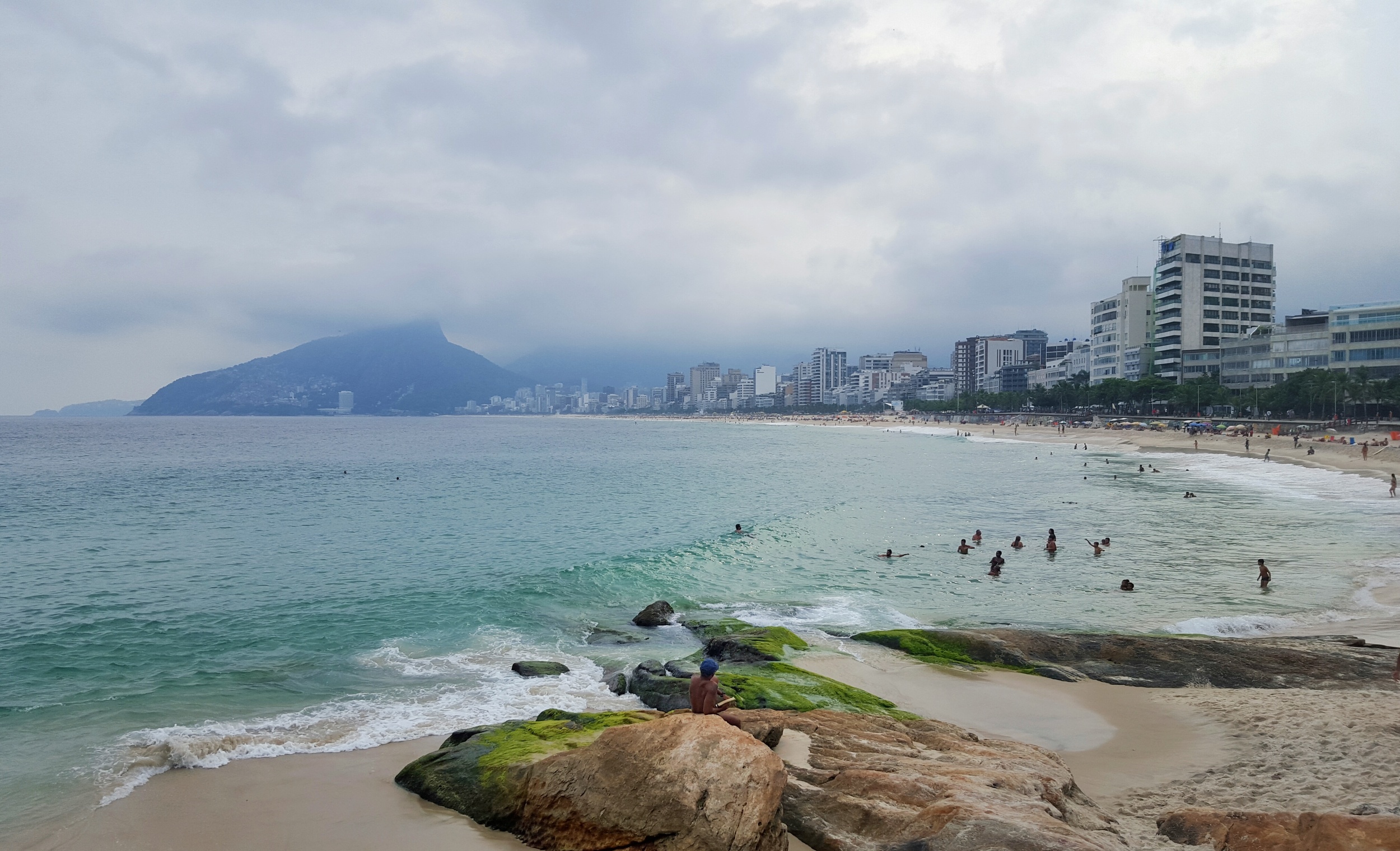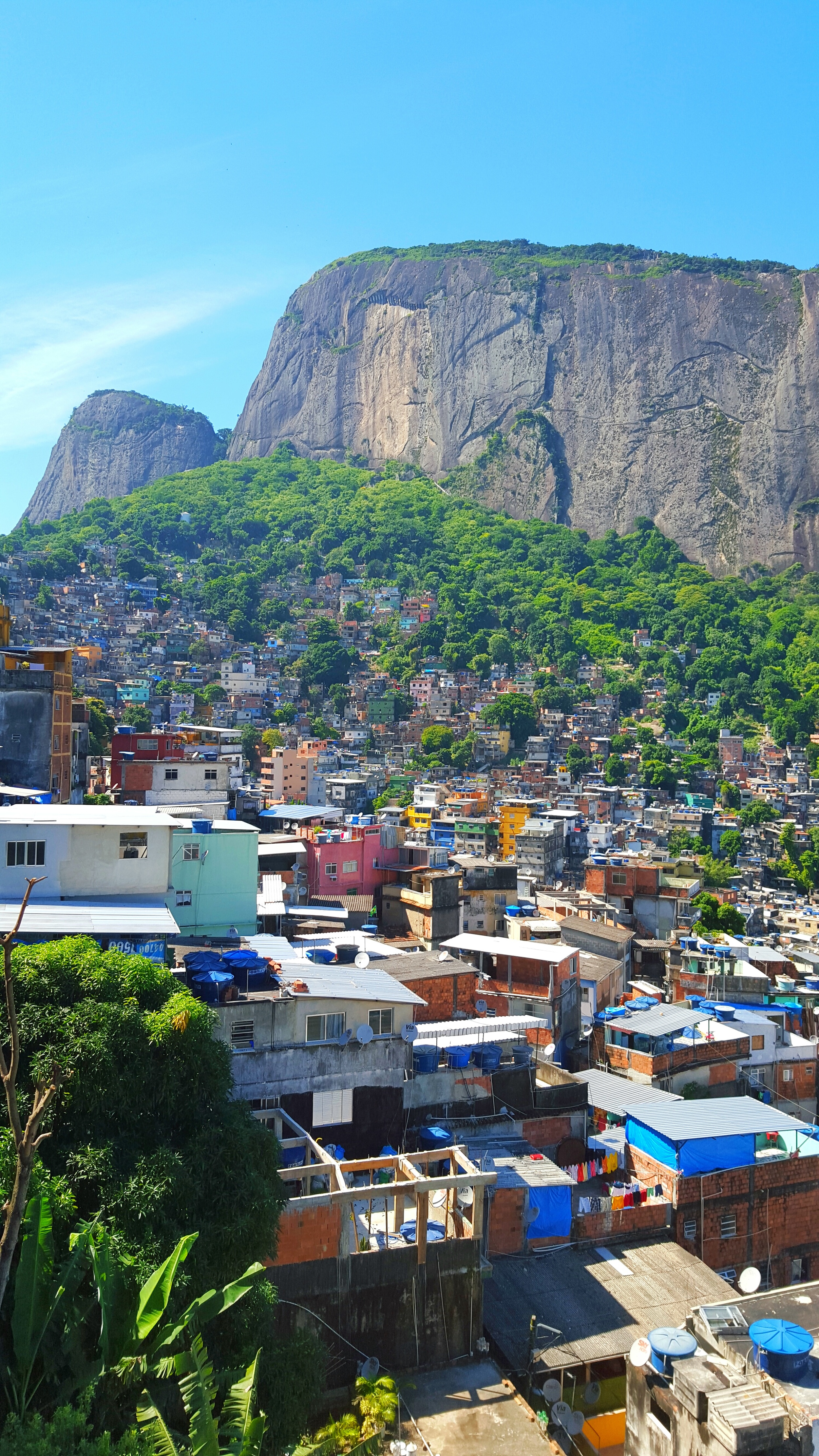What To Do in Rio de Janeiro
Christ Redeemer (Cristo Redentor):
Being one of the Wonders of the World, this can obviously not be missed when you visit Rio De Janeiro. When you think Rio, I'm sure the famous Christ Redeemer statue is the first thing that comes to mind. And for that reason alone, you should definitely go see it. And I would highly recommend hiking there. It might be painful at times, tiring, and exhausting, but it's SO worth it once you reach the top. I'm gonna be honest with you, I regretted it at points during my hike considering I was expecting it to be a nice, calming 2 hour hike, but it turned out to be 4 hours of walking and sprinting (click here to find out why), but when I got there I felt like I was on top of the world. And in a way I sort of was, seeing as Christ Redeemer sits atop Corcovado Mountain at 2320 ft above sea level.
If you do decide to make the hike, don't use the very dishonest app, Maps Me, to take you there. It'll lie to you and tell you you're only 34 minutes away from your destination, when it really means to tell you that you have 2 hours left. And don't take the escalators like a baby once you get there either. Take the stairs. Like a champ.
See how foggy it can get if you visit Christ Redeemer on a cloudy day? I had to wait around for the clouds to move out of the way and snapped a few quick pics before they rolled back in again.
The hike is actually only supposed to be 2 hours. My app took me through some sketchy back route lined with signs saying not to be there by yourself... But there is living proof that it's only supposed to be 2 hours. A Scottish couple I met at my hostel made the hike the day before I arrived and suggested I do it too, which is why I gave it a shot. Use Google Maps instead of Maps Me.
If you wuss out of the hike, they've got busses and a train that can take you up and back down. Be warned though, the busses only sell tickets both ways. So if you climb all the way up, you'll have to climb all the way back down. Or take the train, which ends up being about R $25. I learned that the hard way, when I tried to take a bus back down and they told me I couldn't. I almost had a fit just thinking about having to take the 4 hour hike back down, until in very broken English, I was told I could take the train. Thank. God.
Another tip for when you visit Christ Redeemer: check the skies out before you head out. Don't trust your weather app. I think the moral of the story here is not to trust any app while in Rio. The forecast for my week in Rio was showing thunderstorms all day 'err day. But it was sunshine and butterflies the entire time. You don't want to go up to Christ Redeemer if it's cloudy or foggy out because you won't be able to catch the wicked view of the city. And looking up at Christ Redeemer won't be as impressive either. It'll just be foggy. You'll literally be in a cloud, and as cool as it sounds, you will have made it all the way there for nothing.
The view of Rio de Janeiro from the top of Corcovado Mountain and Christ Redeemer
Parque Lage:
Once a sugar mill during the colonial times, belonging to the governor of Rio de Janeiro in the 16th century, now just a sweet-looking mansion in the middle of a rainforest-like garden.
Parque Lage is a public park that sits at the bottom of Corcovado Mountain (the one with Christ Redeemer). It'd be a great idea to visit Parque Lage on the same day you visit Christ Redeemer since it's on the way there. That is - if you go the right way because your maps app doesn't take you through some sketchy back route...
You won't need to spend much time at Parque Lage, but you should plan on stopping here for lunch or a light snack. Start off with a stroll through the beautiful lush property and end it off by stopping in at the cafe open to the public INSIDE the mansion.
Sugarloaf Mountain (Pão de Açúcar):
There are two peaks that make up the iconic Sugarloaf- the first one being Morro de Urca, and the second being the infamous Pão de Açúcar. They're connected by two sets of cable cars and like Christ Redeemer, you can either hike up Sugarloaf or hitch a ride.
But first- Sugarloaf? Kind of a weird name right? It was named in the 16th century during the prime sugar cane trading period in Brazil and apparently sugar was packed into a mould to be more easily transported on ships, which resembles the shape of Sugarloaf Mountain. Nooow you know!
It's super simple to hike up the first mountain. They've got wooden steps most of the way and ropes to help you get through the steep areas, but the climb only takes about half an hour. Not so bad compared to my 4 hour climb to Christ Redeemer... But to climb the second mountain, you'll need to go with a guide. The second mountain is so steep that you'll have to be helmeted and harnessed in to rock climb most of the way. Or you can do like I did and hike up the first hump and cable car it up the second one.
The views are stunning from both the first and the second peak and they've got shops, cafes, mini restaurants and juice bars along the way - a great opportunity to grab frozen yogurt or a popsicle after your hike!
And a little insider tip - if you go at night, there are zero crowds, you'll have the whole place to yourself, and you'll get a phenomenal view of the city's night lights.
The view from the top of the first peak on the way up Sugarloaf Mountain
Escadaria Selaron:
The famous stairs of Rio. Escadaria Selaron is a set of 250 steps covered in tiles that were either collected from old construction sites in Rio or donated from visitors travelling from all around the world. I guess Snoop Dogg and Pharrell Williams thought it was cool too - cool enough to shoot their music video "Beautiful" here.
The artist, Jorge Selarón, made it his life's mission to finish the masterpiece we now call Esacdaria Selarón. Not long ago, in 1990, he started by renovating the steps just outside his house, but it soon became an obsession to carry on to the next step as soon as one was done. Even though he said it was never complete, all 250 steps are covered in tiles and bits and pieces of ceramic and mirror, some hand painted by him personally. Jorge's journey ended here, when he was found dead laying at the bottom of the steps in January of 2013, and was believed to have set himself on fire.
The ending of that story was super depressing, I know- sorry about that. But trust me when I say that you won't be feeling depressed when you witness the work he put into this beautiful work of art.
The stairs go on forever - this photo was snapped towards the top where it's less crowded.
Samba in Centro:
Samba party in the streets of Centro
I'm not much of a drinker. I'll drink socially, you know, have a Somersby with a meal when I'm out with a friend. It's not often I go out partying and drink to get drunk. But oh boy, Samba Night was something. Every Monday night, starting at something like 8pm, there's a MASSIVE and INSANE Samba party out in the streets of Rio in a neighbourhood called Centro. There's just groups of people who set up shop in the middle of the narrow streets and start playing music. And there's so many people around that you can barely move, but everyone is there just to drink, dance, and have a good time, and let me tell you - it's definitely a good time. The streets are lined with drink vendors. They've got cute little carts and sell caipirinhas (Rio's very awfully-tasting, but effective drink), caipi-vodkas (caipirinhas with vodka instead of cachaça which is what makes it awful-tasting), and beer. They're not the cheapest here, so if you plan on drinking lots that night, maybe have a couple before you head over.
Make sure you go with a group of people. This neighbourhood isn't the safest during this time of the night to be wandering the streets alone and drunk. It's near a favela (a slum neighbourhood), where sometimes shady shit goes down. I'm all for girl power and being independent and strong and everything, but if you're a chick, DEFINITELY don't go by yourself. I went with a group from my hostel and after losing a part of the group, I followed a local we met to go looking for them. Because the streets are so crowded, I can't even count how many times men would grab at my arm and pull me over when I was walking by, with a grip so tight, I had to pry their fingers off me. It's just for your own safety. Play it smart. Play it safe.
If you're going to party on only one night while you're in Rio, let Samba Night be the one night.
On a more historical note about Samba Night: It takes place at Pedra do Sal (Rock of Salt) in Centro, the birthplace of Samba. It's historically important because of its close proximity to the Praça Mauá port, where the first African immigrants from Bahia landed in Brazil in the 17th century. It was a large slave market during this time before becoming the culturally well-known birthplace of Brazil's dance, SAMBA.
Copacabana and Ipanema Beach:
Both Copacabana and Ipanema are the most famous Brazilian beaches. They're the ones with the geometric black and white wave pattern sidewalk that runs along both beaches. Yes, both beaches are very alike, but you've got to visit them both. They might look similar, but they've just got a different feel to them.
I definitely found that Copacabana was more touristy and infested with people trying to sell you stuff. There are local vendors everywhere, but they were way more in-your-face and annoying at Copacabana. To the point where I'm lying there sleeping, and they came over to wake me up and force feed me peanuts.
You should also watch your back when you're at Copacabana. Lots of thieves. Ask the people I met at my hostel who were only planning to stay in Rio for a week but were stuck there for 6 weeks waiting for travel documents, because their bag with their passports, camera, wallet, money, and basically everything important was snagged from Copacabana. But the silver lining is that they got to stay in Rio de Janeiro for that much longer and there are much muuuch worst places to be stuck.
Ipanema Beach
Ipanema is a richer area- more expensive shops, more expensive accommodations, more expensive restaurants - in fact, it's the most expensive place to live in Rio. It's less touristy, less crowded, and just felt more relaxed. I LOVED Ipanema Beach. The view is stunning - two mountains called Dois Irmãos, or Two Brothers, sit at one end of the beach. It's an absolutely stunning view. And the beautiful people that crowd the beach here isn't a terrible sight either! The vendors don't bother you as much here, but if you want a cold beer, a caipirinha or some coconut water, they walk around shouting, so it's super easy to wave one of 'em down. If you've ever heard the song "Girl from Ipanema", this is the beach they refer to.
Wherever you decide to go for a dip, whether at Copacabana, Ipanema, both, or elsewhere, make sure only to go into the water where the locals swim. The waters in Rio are very polluted and can cause harm to your health if you're hanging out in unsafe water for a long time. Don't freak though and not go in the water at all - just be smart about it and swim where everyone else swims. Oh- and also, the waves are BOSS over there. So be careful, because they'll sweep you right in.
Arpoador:
The view of Ipanema Beach from Arpoador Point
Arpoador is most known for being a phenomenal spot to watch the sun set. It's a series of giant rocks that sit between Copacabana Beach and Ipanema Beach and jets out into the ocean, offering a fantastic panoramic view. This is obviously another thing you'll have to do weather permitting.
Favelas:
A "favela" is defined as a "slum" neighbourhood in Brazil, but they're often misunderstood to be strictly linked to crime and violence. That's not to say there isn't any, but there's so much more to them than meets the eye. But what does meet the eye looks pretty darn good!
My visit to the favelas gave me the cultural insight of Rio that I was looking for. Sure, the beaches and hikes were amazing, but I wanted to dive into some of Rio's hidden culture. The culture you don't initially think of when Rio de Janeiro comes to mind. And this did just that.
Click here to read more on visiting favelas in Rio de Janeiro.
Tijuca National Park Waterfalls:
Rio de Janeiro is filled to the brim with little hidden gems. Wherever you go, there's probably a trail or the perfect place for a view of the city, or a waterfall within a 5 km radius. Along my grueling trek up to Christ Redeemer, I accidentally discovered a few little streams that led to gorgeous waterfalls tucked away in the corner.
There are a few that surround the Parque Lage area, that you could hit up on the same day you see Parque Lage or Christ Redeemer, called "Cachoeira do Chuveiro", "Cachoeiro does Primatos", and "Cachoeira da Gruta". It might take some time and sweat to get there on foot, but I promise you that it will all be worth it once you get there.
Food:
I can't say I had much of an appetite while I was in Rio, and for all of you who know me, I know I know. I didn't have much of an appetite? Apparently a broken heart is the only thing that will stop me from devouring everything in sight (read about my personal journey here). From what I did consume though, here are my recommendations:
Por kilo:
"Por kilo" means "by weight", and these kinds of buffet style restaurants mean just that. You start off by piling as much or as little food your heart desires onto your plate. They then weigh your food and print off a receipt for you, which you'll use to pay for your meal after having eaten. This is a great budget-friendly option because you can get a full plate of food for something like R $10, which equals to about $3 USD. Some places are obviously more expensive than others, but most of them advertise their prices on signs in their windows, so you know what you're getting yourself into before even stepping foot inside.
Açai:
We've all heard of açai berries by now, but when you order an açai in Rio, they give you a cup of what looks like purpleish-black pudding. It kind of looks like just dark poop in a cup, but it's delicious and refreshing. It's like a berry slushy and you can find them around all the tourist attractions as well as the local streets.
Fruit juice:
Rio is big on juices. On every corner of what seemed like every street, there's a juice bar where you can pick all the fruits you'd like (by pointing and charade-ing unless you speak Portuguese), which they'll throw together for you into a juice smoothie.
Coconut water:
Coconuts are sold EVERYWHERE. They're perfect for sipping on the beach. The coconut water is refreshing, and once all the water's gone, you can ask them to chop open the coconut to eat the meat inside. Yum.
Caipirinhas (pronounced ky/pee/REE/nyah):
Recipe:
- Lime slices
- Crushed ice cubes
- Sugar
- Cachaça (a cheap vodka-ish white alcohol that tastes AWFUL). There are different grades of cachaça you can get. The "21" bottle has apparently adopted the nickname of "the drink of the homeless" in Rio, because it's so damn cheap (and terrible).
Every time this was made in front of me, the portions were different, so just add to taste, I guess? It also depends on how many people you're making it for. My hostel mates and I found it cheaper to just buy the ingredients and make it back at our hostel before going out, since the most expensive ingredient is cachaça, and a decent grade full bottle of it costs R $8, whereas to buy one caipirinha while you're out costs the same price.
I'm just gonna lay it out for you. They don't taste good. But they hit you hard. And if you're in Rio, you'll have to try at least one. Then hit up the Samba party.
Coxina:
Deep fried pear-shaped cornmeal dough stuffed with potatoes, cheese, and shredded chicken that don't feel the healthiest, but are a tasty afternoon snack.
Queijo:
This was my go-to. It's some sort of sometimes square, sometimes rectangular deep-fried dough containing slices of meat (normally ham) and cheese.
Churrascaria:
Like I mentioned above, I didn't have much of an appetite while visiting Rio, so eating at a Churrascaria wasn't my priority. But this is something you should definitely experience while you're there. They're all you can eat buffets that are brought to you. They're all about the meat. The servers come to your table with a sword of meat and cut it straight onto your plate. They keep coming around and around until you're so full that you'll have to be rolled out of the restaurant.
What not to do:
Museum of Modern Art:
I was told there would be a helicopter suspended in the air. There wasn't. That is all.
Not as cool as a suspended helicopter, but there were guns there. made of metal or plastic or something. in a case. Just giving you a heads up - this was the most exciting thing there...
Shopping:
I came to Rio thinking the shopping was going to be phenomenal, even when I was told by Brazilian people I know that it isn't great. For some reason, I had this stereotypical idea that they'd have great shopping. The shopping malls, vendors on the beach, and even the markets don't have prices you'd think they'd have. For example, markets and vendors on the beach sell these really fast-drying, thin, silk-like beach towels. And as much as they're practical and pretty, they cost R $30 or $10 USD. And they don't budge on price. They may have a set agreement or something amongst all the vendors because they don't budge even a little bit on pricing. And you know the whole walk-away bargaining tactic? Yeah, it doesn't work. They're just like "OK, BYE FELICIA".
Besides street markets and beach vendors, Rio has a couple big shopping malls. The ones I explored are Botafogo Praia Shopping and Leblon Shopping. Let me save you the trouble. There's not much in the Botafogo mall, so don't even bother wasting your time. However, the Leblon mall is lined with designer stores like Salvatore Ferragamo and Dolce & Gabana. But they also have cute little Brazilian stores that sell expensive things... Since my hike up Christ Redeemer made my butt Brazilian, there was no choice but to splurge on a Brazilian bikini at this adorable little shop in Leblon called BlueMan.
Jardim Botanico:
Translated, Jardim Botanico means Botanical Garden. It was originally on my list of things to see and places to visit in Rio, but a few people I met in Brazil said that if I was only there for a week, to not waste my time with it. They said it's just got a lot of plants and not much to see. But if you're into that, then go for it.















